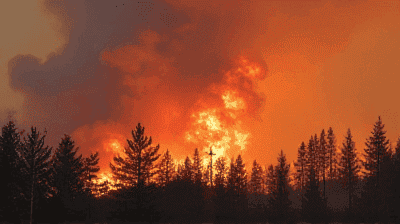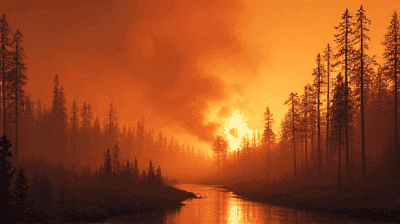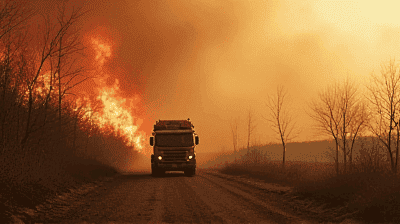
Wildfires have become increasingly prevalent in many parts of the world, exacerbated by climate change, land management practices, and urban development. As they rage across forests and grasslands, they release vast amounts of pollutants into the atmosphere, significantly affecting air quality. The consequences of this pollution extend beyond the immediate vicinity of the fires, impacting areas far downwind and putting the health of millions at risk.
Wildfires, also known as forest fires or bushfires, are uncontrolled fires that burn in natural areas such as forests, grasslands, and deserts. They can be ignited by natural causes such as lightning strikes or human activities such as campfires, discarded cigarette butts, or arson. Wildfires are a natural part of many ecosystems, playing a role in nutrient cycling and habitat renewal. However, when they occur under extreme weather conditions, they can quickly escalate into devastating events.
Several factors contribute to the increased frequency and severity of wildfires:
Climate Change: Rising temperatures, prolonged droughts, and changing precipitation patterns create ideal conditions for wildfires to ignite and spread.
Land Management Practices: Fire suppression strategies that have been used over the years have led to the accumulation of dry biomass in forests. When wildfires do occur, they tend to be more intense due to this buildup.
Urban Development: As human populations expand into fire-prone areas, often referred to as the wildland-urban interface, the potential for wildfires to impact populated areas increases.

Wildfire smoke is a complex mixture of gases and fine particulate matter produced by the combustion of organic material. The primary components of wildfire smoke include:
Particulate Matter (PM): This includes a variety of tiny solid or liquid particles suspended in the air, such as soot, ash, and organic compounds. PM can be classified based on its size, with PM2.5 (particles less than 2.5 micrometers in diameter) being particularly dangerous due to its ability to penetrate deep into the lungs.
Volatile Organic Compounds (VOCs): These are organic chemicals that can evaporate into the air and contribute to air quality issues. During wildfires, VOCs can be released from burning vegetation and soil.
Carbon Dioxide (CO2): This greenhouse gas is produced during combustion and contributes to global warming.
Carbon Monoxide (CO): A colorless and odorless gas that can be produced in significant amounts during incomplete combustion. CO can interfere with the body's ability to transport oxygen.
Nitrogen Oxides (NOx): These gases are produced during combustion and can lead to the formation of ground-level ozone, a harmful air pollutant.
Wildfire smoke can travel long distances depending on wind patterns, atmospheric conditions, and the intensity of the fire. Smoke plumes can rise several miles into the atmosphere, affecting air quality in regions far from the fire's origin. During large wildfire events, it is not uncommon for cities hundreds of miles away to experience degraded air quality and health effects.
Exposure to wildfire smoke can have both short-term and long-term health implications. The severity of these effects often depends on factors such as the composition of the smoke, duration of exposure, and individual health conditions.
Acute Health Effects: These can include respiratory issues such as coughing, throat irritation, shortness of breath, and exacerbation of asthma. Individuals with pre-existing respiratory conditions, children, and the elderly are particularly vulnerable.
Chronic Health Effects: Long-term exposure to wildfire smoke may contribute to the development of chronic respiratory diseases, cardiovascular problems, and even neurological effects. Studies have suggested a link between prolonged exposure to PM2.5 and increased mortality rates.
Certain populations are more susceptible to the health risks associated with wildfire smoke:
Individuals with Pre-existing Health Conditions: People with asthma, chronic obstructive pulmonary disease (COPD), or other respiratory illnesses are at heightened risk.
Children and the Elderly: Children’s lungs are still developing, and older adults may have weakened respiratory systems, making them more vulnerable to the effects of smoke exposure.
Pregnant Women: Emerging research suggests that pregnant women exposed to wildfire smoke may face risks related to fetal development and birth outcomes.

Wildfires can have severe economic ramifications for local, regional, and national economies. These include:
Direct Costs: This includes firefighting efforts, evacuation expenses, and damage to property and infrastructure.
Indirect Costs: Reduced tourism, loss of agricultural productivity, and increased health care costs due to smoke exposure can all contribute to economic loss.
Insurance Claims: The financial burden on insurance companies can result in higher premiums for homeowners in fire-prone areas.
Wildfires also have significant impacts on ecosystems and the environment:
Habitat Destruction: The destruction of habitats can lead to loss of biodiversity, affecting various species of plants and animals.
Soil Degradation: The removal of vegetation during a fire can lead to soil erosion and degradation, impacting water quality in adjacent areas.
Carbon Emissions: Wildfires release large amounts of carbon back into the atmosphere, contributing to climate change and reinforcing the cycle of extreme weather conditions that promote more wildfires.
Implementing sustainable land management practices can significantly reduce the risk and severity of wildfires. This includes:
Controlled Burns: Prescribed burns can help reduce the buildup of fuel in forests and grasslands, minimizing the risk of larger, uncontrolled fires.
Thinning Projects: Removing excess vegetation can create healthier forests that are less prone to catastrophic wildfires.
Communities can enhance their resilience to wildfires through:
Education and Awareness: Informing residents about fire risks and preventive measures can encourage community involvement in fire safety.
Creating Defensible Space: Homeowners should maintain a defensible space around their properties by clearing flammable materials and creating firebreaks.
Communities should establish air quality monitoring networks to track pollution levels during wildfire events. This allows for timely alerts and can inform the public about when to take protective measures.
Advancements in technology can improve air quality monitoring and forecasting, allowing for better management of air quality during wildfires. Mobile applications and online platforms can provide real-time data to communities.
During wildfire events, public health officials should issue clear guidelines for individuals, particularly vulnerable populations. This can include:
Staying Indoors: Encouraging people to stay inside during heavy smoke conditions can mitigate exposure.
Using Air Filtration: Recommending the use of air purifiers or HEPA filters can help improve indoor air quality.
Ensuring that vulnerable populations have access to healthcare services during wildfire events is critical. Public health campaigns can raise awareness about the importance of managing chronic conditions in relation to smoke exposure.
Post-fire recovery efforts should focus on ecological restoration to improve resilience against future wildfires. This includes:
Replanting Native Vegetation: Restoring native plant species can help stabilize soil, prevent erosion, and promote biodiversity.
Monitoring Ecosystem Health: Regular monitoring can help identify areas needing further attention and restoration.
Supporting communities affected by wildfires is essential for recovery. This can include:
Mental Health Services: Providing mental health support for individuals impacted by wildfire events can aid in recovery and resilience.
Economic Assistance Programs: Governments and organizations can offer financial assistance to help affected businesses and individuals recover.

Policymakers must recognize the complex relationship between wildfires and air quality. Comprehensive policies should address:
Climate Change Mitigation: Addressing the root causes of climate change through emission reduction strategies and sustainable practices is essential to reduce the risk of wildfires.
Land Use Planning: Implementing smart land use policies that prevent development in high-risk areas can protect communities and ecosystems.
Funding for Research: Allocating funds to research on wildfire behavior, impact assessment, and effective mitigation strategies can enhance understanding and preparedness.
Wildfires represent a significant threat to air quality and public health, requiring urgent action from individuals, communities, and policymakers. By understanding the impact of wildfires on air pollution and implementing effective mitigation strategies, we can reduce the health risks associated with wildfire smoke, protect our environment, and promote resilience in the face of changing climatic conditions. Collective efforts toward prevention, monitoring, and recovery can pave the way for healthier and safer communities.